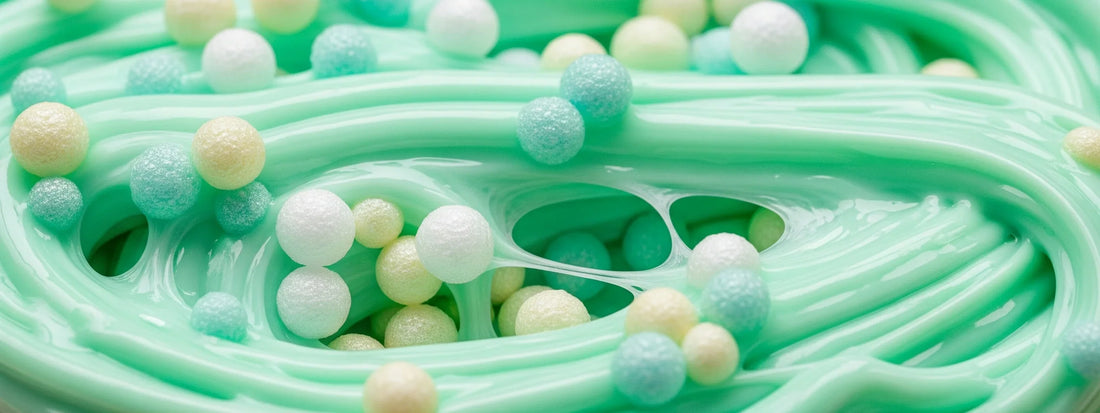
The Irresistible Pop: Unpacking the Science Behind Crunchy Slime ASMR
Share
Slime, once a simple childhood craft, has evolved into a sophisticated form of ASMR (Autonomous Sensory Meridian Response) art. Crunchy slime, in particular, with its captivating sound effects, has exploded in popularity on platforms like YouTube and TikTok. You might wonder, why do so many people get so much satisfaction from simple plastic goo and foam beads? The answer lies in a fascinating blend of neuroscience and sensory perception.
The Multisensory Experience: Why We're So Hooked
When you watch a crunchy slime video, your senses are immediately engaged. First, there's the auditory component. The high-frequency "pops," the mid-range "squishes," and the gentle rustle of foam beads being squeezed all trigger a release of dopamine in your brain. This chemical is key to feelings of pleasure and satisfaction. This "satisfying response" is the same neurological mechanism that makes popping bubble wrap so addictive or explains why we love peeling dried glue off our fingers.
Then, there's the visual aspect. Your eyes track the dynamic process of the slime being stretched, folded, and compressed. Even without touching the slime, your mirror neurons are activated, creating a sort of phantom tactile sensation as if you were performing the action yourself. This sensory crossover not only provides a virtual sense of touch but also enhances the overall feeling of pleasure. This is why crunchy slime ASMR isn't just an auditory feast; it's an immersive experience that engages both sight and sound.
The Perfect Recipe: A Guide to DIY ASMR-Worthy Slime
Creating ASMR-grade slime isn't just about mixing glue and foam beads. It requires precise ratios and key steps to ensure the final product has the perfect balance of stretch and resistance for the most satisfying sounds.
Essential Ingredients
- White School Glue: 4 ounces (about 120 ml), serving as the base polymer.
- Contact Lens Solution: 1 tablespoon, acting as the activator.
- Baking Soda: 1/2 tablespoon, mixed with the contact lens solution to create the perfect cross-linking reaction.
- Foam Beads: The soul of the crunch. Opt for medium-sized beads for the best sound. Beads that are too small will be muted, and beads that are too large may fall out easily.
- Food Coloring or Acrylic Paint: A small amount for coloring.
Step-by-Step Instructions
- Prepare the Base: Pour the white glue into a bowl.
- Add Color: Before adding the activator, mix in your favorite food coloring. Neon or pastel colors often look best on camera, adding a visual pop to your videos.
- Activate the Slime: Combine the contact lens solution and baking soda. Gradually add this mixture to the glue, stirring constantly until the slime begins to form and pull away from the sides of the bowl.
- Mix in the Foam Beads: This is the most critical step. Transfer the slime to a flat surface and knead the foam beads into it in small, gradual increments. Avoid adding too many at once, as this can make the slime stiff and the sound dull. Slowly work the beads in, ensuring they are evenly distributed.
- Let it Rest for 24 Hours: This is a step many beginners miss. Letting the slime rest allows the polymer chains to fully develop, creating the ideal texture and resistance for the most satisfying sounds.
Capturing the Perfect Crunch: Recording Techniques
The sonic signature of good crunchy slime primarily resides in the mid-to-high frequency range, around 1-4 kHz. This is where the pops of the foam beads really come to life. To capture the essence of these sounds, you need more than just well-made slime; you also need good recording techniques.
- Use a Quality Microphone: Professional ASMR creators often use condenser microphones designed to pick up subtle sounds. If you're a beginner, even your phone's built-in microphone can work well if you place it close to the slime.
- Choose a Quiet Environment: Any background noise will detract from the ASMR experience. Find a quiet room free of fan hums or traffic noise.
- Use the Right Playback Equipment: When watching these videos, using neutral-tuned headphones (rather than bass-heavy ones) will let you hear the most accurate sound representation, from every subtle bubble pop to the gentle stretch of the polymer.
Whether you're making your own or just enjoying someone else's creations, crunchy slime ASMR proves that sometimes the most effective relaxation techniques come from the simplest pleasures—reimagined through the lens of modern neuroscience.
Have you ever tried making your own slime? What is your favorite type of ASMR sound?
